A couple of days ago, The Atlantic, a leading American Magazine carried an article titled “The Tools of Espionage are Going Mainstream”, written by a senior scholar in American intelligence studies. The focus of the article was to assess how traditional intelligence operations, especially of the Cold War and before in the Europe and America, were an epitome of a level of dignity despite secrecy, considering the fact that the targets of intelligence operations were political leaders, the military and intelligence operatives.
However, according to the article, the tools of espionage have now begun to transcended the officialdom and reached the mainstream populace. The blame for this perversion is credited to Russia and the author terms this perverse act Deception 2.0 and suggests the birth of “a whole new world” that Uncle Sam will have to live and thrive in.
As a student of Intelligence Studies, I find it rather eccentric that analyses of concepts are limited to the Western world. India has been the victim of the Deception 2.0 much before and the West, like many a times in the history, has been slow to wake up to the reality. Hence, this article is a narration of the stages in which Uncle Sam has been slowly waking up over the decades.
On the morning of 11 September 2001, as the United States was struck by kamikaze style attacks by a group of terrorists owing allegiance to al-Qaeda, the country’s intelligence agencies were caught by surprise. It is another matter that these were not the first terror attacks on the US, and thence, the ‘surprise’ may have been a result of intelligence failure, or policy failure, or a combination of both.
A whole host of analyses has been drawn by experts and academics ever since. But one thing that the West had missed and India had in abundance was experience in dealing with terrorism.
India was already dealing with state sponsored terrorism from Pakistan, much deadlier than ideological terrorism, and had witnessed some of the worst attacks like the 1993 Bombay Blasts, as part of the ISI’s “Plan K2M” (Khalistan, Kashmir and Muslim Militancy). Incidentally, 1993 was the same year the World Trade Center bombing took place in New York. India had tried her best to enlighten the US of the costs of terrorism on national security, but the US was slow to wake up to the reality. It would take nearly a decade and 3000 deaths before the US began to borrow some of India’s experience.
The saga did not end there. The US along with her NATO allies (ISAF) embarked on an operation in a distant land called Afghanistan as part of the Global War on Terror in 2001. With the quick ouster of the Taliban regime, a solution seemed looming. But the American troops were soon to realise that they had little experience, if any, in counterinsurgency, let alone in the rugged mountains of Afghanistan, dealing with a different set of people with tribal loyalties.
After severe setbacks, and modicum of improvements owing to British historic experiences with the Afghans, the US has sustained operations but conclusion still seems distant. Even here, it was the Indian experience that the US sought to study. Once again, the US had belatedly, but suddenly, woken up to the reality that India had dealt with in her north-eastern states and Kashmir for long. Several studies were conducted by US’ Rand Corporation and the Army Staff College to adopt lessons from India’s CI experience.
If this has been the case of threats from non-state actors, in the recent times, a new format of threat has emerged in the US’ threat perception originating from her arch rival, Russia. Western academics began to devise terms such as hybrid warfare, hybrid threat, hybrid adversary to explain Russia’s behaviour in her neighbourhood. Numerous definitions have been developed so far, but suffice to understand that the concept includes an adversary’s ability to incorporate conventional and unconventional methods to attack. These methods can range anywhere between military action and covert actions like subversion, sabotage, black propaganda, etc.
In India, unsurprisingly, the term did not gain much mileage in terms of academic rigour, as was seen in the West, because it was once again an age-old experience she had with Pakistan. Pakistan has been employing all means within the spectrum of hybrid warfare since the days of independence (Qurban Ali Doctrine), through the worst phases of 1980s, 90s and the new millennium (Plan K2M), up until now (Operation Smear and others). Nevertheless, the US woke up to this reality only in 2008.
If this has been the state of affairs until recently, the article in the Atlantic astonishingly describes a new format of threat from Russia, namely Deception 2.0, which ironically has been employed against India and her citizens by the ISI at least from the 1980s with great dedication. The concept of Deception 2.0 drives on the idea that deception/fraudulent information will be used not against political and security officials, but against the innocent citizens in order to provoke them against one another, usually on social issues.
The author uses the example of two groups of Facebook—Heart of Texas and United Muslims of America—to illustrate her analyses. With polarised ideologies, the groups were expected to protest for their cause, which would then transform into violent clashes, all instigated by Moscow. Such tactics of turning the citizens against one another through falsehood and misinformation is what the article pronounces as an unprecedented tactic and terms it Deception 2.0. Is Uncle Sam once again slow to wake up to the reality? Have scholars of Intelligence Studies failed to look elsewhere for answers?
The answer to both the questions: Yes! India’s diversity and secularism has offered a tempting target to Pakistani ISI, who has been convinced on at least four occasions that victory through conventional means is impossible. Therefore, while preparing for conventional means since 1947, the ISI has perennially kept alive its ownDeception 2.0. Communal polarisation in India, especially after the destruction of Babri Masjid and the consequent communal riots in Bombay and elsewhere in India, has given the ISI a feasible option in bleeding India through incorporation of deceptive tactics and spread of fraudulent information with the goal of pitting communal and regional communities against each other. The earliest signs of ISI’s deceptive operations with the intent of instigating communal violence was seen in Punjab during the Khalistani agitation, later in Bombay and other parts of India with an aim of instigating Hindu-Muslim clashes.
Not just communal instigations through paramilitary action, ISI’s culpability and connivance was visible even in the use of social media, which forms the crux of Zegart’s analysis in the Atlantic. Dissemination of doctored images led to massive confusion and attempted exodus of north-easterners from a few metro cities during the days of Bodo-Muslim agitation. Social media platforms like Facebook and Twitter have also contributed tremendously in polarising Hindus and Muslims on issues such as “love jihad”, the Ram Mandir and others, which intelligence personnel suspect is a handiwork of the ISI. ISI’s Deception 2.0 has clearly been a reality in India’s threat perception for decades.
Therefore, once again, the West has been slow in waking up to the reality that the world is. As illustrated till now, the decades, especially post 9/11 have been an era of learning for the US and her western allies, albeit at a slow pace owing to the reluctance of listening to their Indian counterparts. However, slowly and gradually, as they study the nature of their evolving threats they will become fully aware of the extent to which India has been troubled by her north-western neighbour.
Once fully comprehended, Uncle Sam will then have to completely open his eyes to observe how India has been successful in her complex and successful experiment of secularism, peace and stability, amidst living in “on old world” where ISI’s operations against her was an amalgam of all her novel threats.As far as western scholars of intelligence studies are concerned—not paying heed to experiences of others, especially countries of South Asia and the developing world, is at best intellectually lethargic, at worst disastrous.





